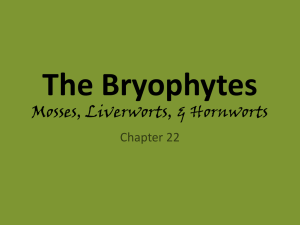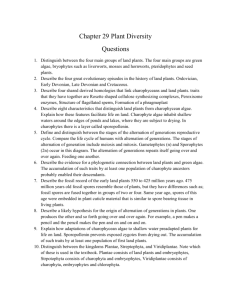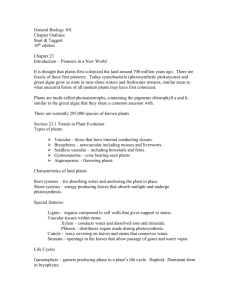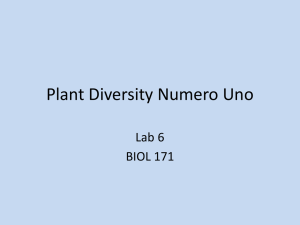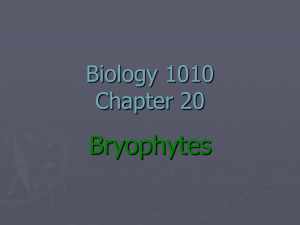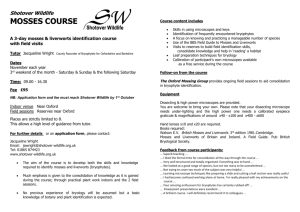Chapter 18
advertisement
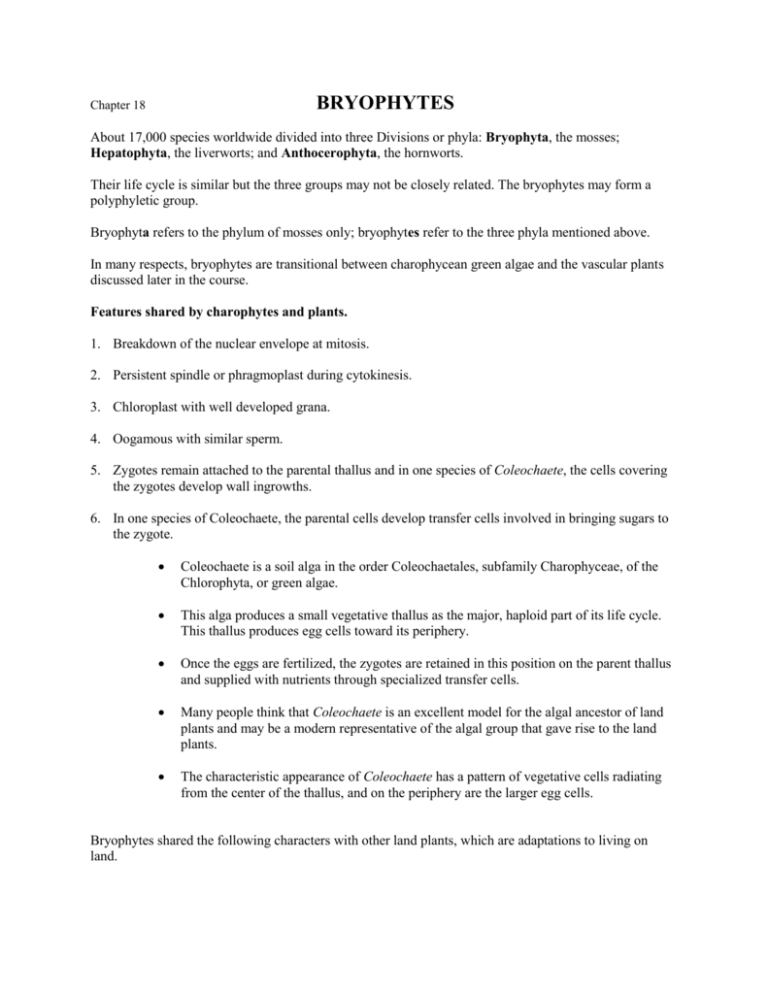
BRYOPHYTES Chapter 18 About 17,000 species worldwide divided into three Divisions or phyla: Bryophyta, the mosses; Hepatophyta, the liverworts; and Anthocerophyta, the hornworts. Their life cycle is similar but the three groups may not be closely related. The bryophytes may form a polyphyletic group. Bryophyta refers to the phylum of mosses only; bryophytes refer to the three phyla mentioned above. In many respects, bryophytes are transitional between charophycean green algae and the vascular plants discussed later in the course. Features shared by charophytes and plants. 1. Breakdown of the nuclear envelope at mitosis. 2. Persistent spindle or phragmoplast during cytokinesis. 3. Chloroplast with well developed grana. 4. Oogamous with similar sperm. 5. Zygotes remain attached to the parental thallus and in one species of Coleochaete, the cells covering the zygotes develop wall ingrowths. 6. In one species of Coleochaete, the parental cells develop transfer cells involved in bringing sugars to the zygote. Coleochaete is a soil alga in the order Coleochaetales, subfamily Charophyceae, of the Chlorophyta, or green algae. This alga produces a small vegetative thallus as the major, haploid part of its life cycle. This thallus produces egg cells toward its periphery. Once the eggs are fertilized, the zygotes are retained in this position on the parent thallus and supplied with nutrients through specialized transfer cells. Many people think that Coleochaete is an excellent model for the algal ancestor of land plants and may be a modern representative of the algal group that gave rise to the land plants. The characteristic appearance of Coleochaete has a pattern of vegetative cells radiating from the center of the thallus, and on the periphery are the larger egg cells. Bryophytes shared the following characters with other land plants, which are adaptations to living on land. 1. Male and female gametangia, called antheridia and archegonia respectively, covered with a protective layer of cells, a sterile jacket layer. 2. Retention of the zygote and developing multicellular embryo within the archegonium of the female gametophyte. 3. Multicellular diploid sporophyte, which results in an increased number of meiosis and many more spores. 4. Multicellular sporangium covered with a sterile jacket layer and internal spore-producing tissue, sporogeneous tissue. 5. Spores with walls containing sporopollenin, which resists decay and drying. 6. Tissues produced by an apical meristem. Charophytes lack all of the above characters. Bryophytes differ from land plants in... 1. Lack xylem and phloem, which are present in vascular plants. Some bryophytes have conducting tissue; the cell walls of the bryophyte water-conducting cells are not lignified. 2. Sporophyte is achlorophyllous and parasitic on the gametophyte, which is the dominant generation. In vascular plants, the sporophyte is dominant and independent of the gametophyte. 3. Sporophyte is unbranched and bears few spores. In contrast with the sporophyte of vascular plants, which is branched and bears many more spores. 4. Bryophytes need water for fertilization to occur. The sperm most swim to reach the archegonium. Nucleotide sequence data and recent fossil discoveries, together with classical morphological characters and newly described ultrastructural features, reveal that bryophytes include the earliest of the extant plant groups to have diverged within a monophyletic plant lineage. COMPARATIVE STRUCTURE 1. Some bryophytes are thalloid. Flat, dichotomously branched, not differentiated into roots, stems and leaves; often relatively thin. 2. The gametophyte of mosses and some liverworts are differentiated into blades and stipes (in contrasts with leaves and stems). The thalli of certain liverworts and mosses contain centrally located strands of cells that appear to have conducting functions. 3. Some have pores, which are considered to be analogous to stomata. 4. The cuticle protects the plant from desiccation. 5. Rhizoids anchor and attach the gametophyte to the substrate. Rhizoids are multicellular in mosses and unicellular in hornworts and liverworts. 6. Cells are interconnected by plasmodesmata with a desmotubule, which is derived from the endoplasmic reticulum. 7. Hornworts and the apical and reproductive cells of many bryophytes have a single chloroplast. The majority of cells have many plastids similar to those of higher plants. This is considered to be an evolutionary remnant of the green alga ancestor. 8. In mitosis, bryophytes and other plants produce preprophase bands of consisting of microtubules that specify the position of the future cell wall. COMPARATIVE REPRODUCTION OF BRYOPHYTES 1. Asexual reproduction: Fragmentation: cluster of cells or pieces of tissue produce an entire gametophyte. Gemmae: cluster of cells or tissue produced in specialized structures called gemmae that produce a new plant. Bryophytes do not produce zoospores for asexual reproduction. The only flagellated cells produced by bryophytes are sperm cells. 2. Sexual reproduction: Antheridia and archegonia are produced on the same plant or on separate plants. Sex chromosomes differentiate male and female plants. Gametpophytes are haploid and produce haploid sperms mitotically. The antheridium consists of a sterile jacket of cells and a cluster of spermatogenous cells. Each spermatogenous cell forms a single biflagellated sperm Sperms need water to swim to the egg. The archegonia consist of a venter and a neck. The neck canal cells disintegrate in the center of the neck when the egg is mature in the venter. The neck is filled with a fluid and the sperm swims through it to get to the egg. The sperm is attracted through chemotaxis. The zygote remains in the venter and it is nourished by the female gametophyte: matrotrophy. Placental tissue already appeared in Coleochaete suggesting that matrostrophy had already evolved in the charophyte ancestors of plants. A multicellular embryo develops without plasmodesmatal connections with the mother gametophyte. Nutrient transport is apoplastic: through the cell walls only. A placenta that interfaces the sporophyte and gametophyte facilitates apoplastic transport. The placenta consists of transfer cells have extensive branched cell walls that increase the surface area between the two generations and facilitate transport. As the embryo develops, the venter undergoes cell division to keep pace with the growing sporophyte embryo. The enlarged venter of the archegonium is called the calyptra. The mature sporophyte consists of a foot embedded in the archegonium, a seta or stalk is present in the phylum Bryophyta, and a capsule or sporangium. Embryophytes All plants produce embryos. The term “embryophyte” can be used as a synonym of plants. Matrotrophy and placenta allows the development of a large sporophyte that can in turn produce many spores through meiosis. There has been a tendency to delay meiosis. The more mitotic divisions that occur between fertilization and meiosis, the larger the sporophyte becomes. Plant sporophytes have shown a tendency to become larger in relation to the size of the gametophytes. Sporophyte of bryophytes. Sporophyte of mosses and hornworts contain stomata bordered by two guard cells. Increase transpiration brings up nutrients from the gametophyte through the placenta. Uptake of CO2 for photosynthesis. Sporophyte of liverworts lack stomata. The epidermal cell wall of moss and liverwort sporophytes is impregnated with phenolic materials for protection. Those of hornworts are covered with a cuticle. The spores of bryophytes and lower vascular plants and the pollen of seed plants are covered with sporopollenin. Sporopollenin is complex mixture of 10-15% cellulose, 10% of xylan (polysaccharide of xylose), 10-15% lignin, and 55-65% lipid. It is extremely resistant to decay and chemicals. Charophyte zygotes are lined with sporopollenin and are resistant to microbial attack. The spores, however, are not covered with sporopollenin. The sporopollenin-walled spores of plants are thought to have originated from charophyte zygotes by change in the timing of sporopollenin deposition. The spores of mosses and some liverworts germinate into a thread-like protonema, which then develops into a gametophyte. The bryophytes are grouped into three phyla: Hepatophyta (liverworts), Anthocerophyta (hornworts) and Bryophyta (mosses). Phylum Hepatophyta There are about 6,000 species of liverworts or hepatics. Most liverwort gametophytes develop directly from spores but some produce protonemata. The gametophyte may be leafy or thalloid. The plant typically is flattened with distinct dorsal and ventral surfaces (dorsiventral). CHARACTERISTICS Thalloid liverworts The thalloid liverworts may be complex or simple. Growth occurs such that the liverwort creeps along a vertical or horizontal substrate. Branching is dichotomous. Gametophytes grow through the activity of a single apical cell. Complex thalloid liverworts exhibit differentiation of the thallus into an upper photosynthetic region including air chambers a ventrally storage zone which contains cells with abundant lipid reserve. The lower surface bears rhizoids. Simple thalloid liverworts lack specialized air chambers but may contain bundles of water conducting tissue. The simple thalloid liverworts Riccia and Ricciocarpus grow in damp soil or are aquatic. Riccia may be unisexual or bisexual; Ricciocarpus is bisexual. Reproductive organs are distributed along the dorsal surface of the gametophyte. The sporophyte is deeply embedded in the gametophyte and consists mostly of a sporangium. Marchantia produces the sex organs in specialized structures called gametophores (or gametangiophores). Antheridiophores bear antheridia. Archegoniophores bear archegonia. The sporophyte consists of a short foot, seta and the sporangium. The sporangium contains spores and elaters to help in scattering the spores. Fragmentation and gemma cups are methods of asexual reproduction. Leafy liverworts There are about 4000 species of leafy liverworts. They are abundant in areas of high humidity and rainfall of the tropics and subtropics. The leafy growth habit consists of three rows of isomorphic leaves or in dorsiventral forms two rows of lateral leaves with or without a reduced row of ventral underleaves. Leaves generally consist of a single layer of undifferentiated cells, and lack a “midrib”. Antheridia are produced on short side branches with modified leaves called the androecium. The archegonium is surrounded by a tubular sheath called the perianth. Phylum Anthocerophyta Hornworts form a small phylum of about 100 species. The gametophyte of hornworts resembles that of liverworts. Liverworts and hornworts are distantly related as shown by being included in separate phyla. CHARACTERISTICS Gametophytic thallus lobed, sometimes branching dichotomously. The thallus becomes round when growing in isolation. Most species have a single chloroplast with pyrenoid in each cell. Some species have many small chloroplasts and no pyrenoids but the apical cell contains only one reflecting the ancestral condition. The thallus has internal chambers inhabited by the cyanobacteria Nostoc. Nostoc is nitrogen fixing bacteria that supplies it to the hornwort. Some species have pores that resemble stomata. Rhizoids are unicellular. Most species are bisexual. Antheridia and archegonia are embedded in the upper surface of the thallus. Gametangia develop from superficial cells but never project above the surface. Multiple fertilization occurs and many sporophytes may develop on the gametophyte. Sporophytes are of indeterminate growth. Sporophyte consists of a foot embedded in the gametophyte and a long capsule or sporangium. A meristematic region develops in the early stages of the sporophyte between the foot and the capsule This intercalary meristem remains active as long as the conditions for growth remain favorable. The sporophyte is green having several layers of photosynthetic cells. The sporophyte has stomata present. Dehiscence occurs along two longitudinal lines. Spores and elaters develop inside the sporangium. Phylum Bryophyta Mosses are a large phylum containing about 12,000 species. Many new species are discovered every year in the tropics. The phylum is divided into three classes, Sphagnidae (peat mosses), Andreaeidae (granite mosses) and Bryidae (true mosses). The class Bryidae contains about 9,500 species. CHARACTERISTICS Protonema gives rise to gametophores, leafy shoots that produce gametangia. Protonema chlorophyllous with multicellular rhizoids. Gametophore leafy with more than three ranks of blades. Gametophyte may or may not branch. Axis with thick walled outer cortical cells and a central strand of smaller cells. Lamina sessile, entire, seldom lobed. Midrib composed of several layers. Laminar cells elongated; hyaline cells: dead, large, barrel-shaped, retain large quantities of water... Stomata present on the sporangial wall. Paraphyllia present in some species: small, branched, uniseriate structures. Gametophores usually unisexual; bisexual species with gametangia on separate branches. Archegonia apical (acrocarpous) or on reduced branches (pleurocarpous). Sporangium opens by an apical lid beneath which the peristome teeth are present. Columella in the sporangium. Seta long and wiry; sporophyte persists for a long period. Seta elongates before sporangium is fully differentiated. Class Sphagnidae The class Sphagnidae consists of one large genus, Sphagnum, and two smaller genera recognized by most bryologists. Evidence provided by comparative DNA sequences and distinctive features of its gametophytes indicate that the Sphagnidae diverged earlier in moss evolution. Protosphagnales appear about 290 million years ago in the Permian. Sphagnum is a cosmopolitan genus of about 400 species, but the plants are variable and the actual number may be smaller. Sphagnum forms gametangia at the tip of special branches of the gametophyte. Sporophyte capsules are nearly spherical and develop on the pseudopodium, which is part of the gametophyte. Seta is very short. The operculum closes the opening of the sporangial capsule. Shrinking of the capsule as it matures builds up the air pressure inside and eventually blows off the operculum with a noise and a cloud of spores. Asexual reproduction by fragmentation is very common. Distinguishing features of the Sphagnidae 1. The protonema of the Sphagnidae consists of a plate of cells, one layer thick that grows by a marginal meristem. The protonema of Sphagnum is similar to the disk-shape thallus of Coleochaete. 2. The erect gametophyte arises from a budlike structure that develops from a marginal cell. The bud contains the apical meristem that divides in three directions, forming leaf and stem tissues. The stem of the gametophyte bears clusters of branches at the apex. The branches bear blades resulting in tufts. The branch blades bear little or no chlorophyll. Those on the stem are chlorophyllous. Blades are one cell thick and have a distinct pattern of large dead cells (hyaline cells) surrounded by narrow, green or red-pigmented living cells. The dead cells have are perforated and become filled with water. Sphagnum can absorb water up to 20 times its dry weight Sphagnum releases large amount of H+ often lowering the pH below 4. 3. The explosive operculum mechanism is unique among mosses. Ecological importance of Sphagnum. Sphagnum occupies 1% of the earth's surface. Peat stores large amount of organic carbon that is not readily released as CO2. Class Andreaeidae. A group of about 101 species that grows on granite or calcareous rocks in northern latitudes. The class comprises two genera Andreaea, 100 species, and Andreaeobryoum, 1 species . Usually grow on rocks and cliffs in cold climates forming cushions or tufts. This is possibly a primitive group. The protonema is unique in having two or more rows of cells rather than a single row. Rhizoids consist of two rows of cells. The sporophyte consists of a foot and a capsule; there is no seta. The capsule is projected out of the gametophyte by an elongated pseudopodium. Capsule has four vertical lines of cells along which the capsule splits. The capsule remains intact above and below these rows of cells resulting in four valves that open when is dry and close when is moist. Class Bryidae Protonema extensive usually forming an uniseriate branched system that precedes the gametophores. Leafy gametophytes develop from shoots on the protonema. Protonemata have slanted cross walls. In a few species, the protonemata are persistent and assume a major photosynthetic role. Multicellular rhizoids present. Many mosses have tissues specialized for water conduction called hadron. Hydroids are water-conducting cells. Hydroids have inclined end cell walls that are thin and highly permeable to water. They lack a living protoplast at maturity just like tracheids but do not have lignin in their cell walls. The hadron forms a central strand in gametophyte stem. Specialized food conducting tissue is called lepton. Leptoids are elongated food-conducting cells that surround the hydroids. At maturity leptoids have inclined cell walls with pores. They have a living protoplast with degenerate nuclei. These two cell types are similar to those found in fossil protracheophytes. Protracheophytes represent and intermediate stage in the evolution of vascular plants, tracheophytes. Leaves are spirally arranged and sometimes have a midrib. Blades are usually one cell thick except at the midrib area. “Like the stem, the cells of the costa can show a great deal of differentiation. These specialized cells include: stereids, guide cells, hydroids and leptoids. Guide cells are noticeable large cells that are continuous with the cells that make up the rest of the leaf blade (the lamina).” Shona Ellis. http://www.botany.ubc.ca/bryophyte/mossintro.html Lamellae: photosynthetic cells that form filaments or plates along the lamina or costa of the leaf. They are found in the Polytrichidae. Paraphyllia are photosynthetic filaments found on the stems of a few mosses. Gametophytes may be unisexual or bisexual. Gametangia may be produced by mature leafy gametophytes, either at the tip of the main axis or on a lateral branch. Sperms are dispersed by water and swim to the archegonium. Moss sporophytes are borne on the gametophytes, which supply them with nutrients. The mature sporophyte consists of a foot embedded in the tissue of the gametophyte, a seta or stalk, and a capsule or sporangium. Cells of both foot and adjacent gametophyte function as transfer cells in the placenta. The setae vary in length according to the species; they may be as long as 20 cm or totally absent. The setae of many sporophytes have a central strand of hydroids surrounded by leptoids. Stomata are normally present on the epidermis of moss sporophytes. Some moss stomata are bordered by only a single, doughnut-shaped guard cell. The calyptra forms a cap at the top of the sporophyte and is derived from the archegonium The base of the capsule may become swollen forming an apophysis. The capsule has an operculum or lid that covers the opening of the sporangium. The sporangium opening has a surrounding ring of teeth called the peristome. The peristome is found only in the class Bryidae and is absent in the other two classes. The teeth of the peristome are adpressed against the epiphragm before the removal of the operculum. The epiphragm is formed by an expanded columella and appears to cover the mouth of the capsule. Asexual reproduction occurs by fragmentation. Bryophytes are important ecologically. Many mosses are members of the pioneer community that invades newly open habitats. Many tropical species are epiphytes. Mosses are important in holding water and releasing it slowly in the ecosystem. Sphagnum is only important commercially moss, e.g. soil conditioner or peat moss. http://avalon.unomaha.edu/lichens/Bio%204380%20PDF/Bryophytes%20II.pdf
